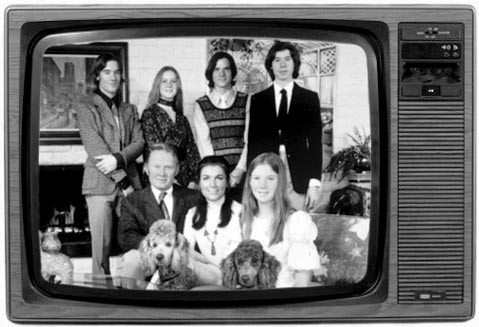Memory from an Epidemic
Helping Out in the Early Days of AIDS

Back in 1990, Alex turned out to be my most secret friend ever.
I was in my thirties. I worked and worked out. After long days in an office downtown, I enjoyed exercise classes, releasing the day’s tensions with dance combinations to pounding disco beats.
My friend Hal and I took the same classes. One evening he asked if I’d check out the AIDS Buddy program with him.
“What’s an AIDS Buddy?”
“It’s for AIDS patients. They need their dogs walked, meals delivered, someone to talk to. They’re dying alone,” Hal explained.
These were the days when people were afraid they might catch AIDS just being in the same room with a patient and when landlords evicted gay tenants and burned everything left in the apartments.
I also knew how hostile Santa Barbara could be toward gay people. In 1971, when I was a sophomore at Santa Barbara High, the first TV reality show, An American Family, filmed scenes on campus. It documented the lives of our classmates, the Loud family. The oldest son, Lance, came out to his family — and to the world — on the show, just two years after the 1969 Stonewall uprising in New York City launched gay liberation. While I admired Lance’s courage for being the first openly gay television character, many others in socially conservative Santa Barbara didn’t. But after a few moments of rumination, I decided to check out the AIDS Buddy training with Hal.
The training was revelatory. We had several facilitators. A physician enumerated the panoply of AIDS-related conditions we would encounter — pneumocystis pneumonia, fungal infections in the mouth, and Kaposi’s sarcoma (KS), a formerly rare cancer-like condition that produces dark lesions on the skin and inside the body.
A nurse taught us how to listen actively. “Don’t be afraid to talk about death; ask them to tell you how they feel about it.”
She gave specific advice. “Many have already lost their friends who are afraid to visit them, and their families, who are ashamed of them. Some have been evicted. If they’re still working, they’re afraid they’ll be fired.”
One lesson was how isolated patients felt from human touch. “Always touch them; don’t hesitate. And help with their pets. A dog’s love is unconditional, and neither dogs nor cats are afraid to sleep on the patients’ beds.”
Another instructor was from Hospice. She was direct. “Do not ask them how they got it. If they want to talk about that, let them bring it up. It’s better to ask what you can do for them.” She also told us that sometimes people can choose when they want to die and that we should be comfortable talking with the patients about their fears.
The program coordinator explained how crucial it was to keep everything we were doing, as well as everybody we were doing it with, a total secret.
She was emphatic. “Almost everyone you know has irrational fears of AIDS contagion. Never tell anybody that you volunteer as an AIDS Buddy. If your coworkers find out, many will refuse to work with you. They won’t use the same telephone, coffee cups, or photocopier.” Even our program meeting places were kept secret with code names.
She had us each practice a false story to tell at the inevitable chance encounters when one of our “outside” friends would encounter us around town with someone from the buddy program. Mine was easy; I’d say, “Oh, I know ’em from the gym.” I used my out-in-public line several times.
We read pamphlets originally written before AIDS, for an older audience: Why We Die at Home and Home Care of the Hospice Patient. The coordinator gave us letters from patients. I still have one, in which the writer pleads, “Please don’t be afraid to touch me.”
When the coordinator invited the first patient to a training session, I was frightened, as I’d never met anybody with AIDS. Our guest was several years younger than I, slim, tan and nicely dressed in brown corduroys and a harmonious plaid, button-down shirt. I thought, “He looks just like me.” He cried softly as we hugged him when the meeting ended. He died several months later.
After completing AIDS Buddy boot camp, I was assigned to Alex (which is not his real name). I was afraid when I met him for the first time at Cottage Hospital, where he’d just gotten his death-sentence diagnosis. But Alex, who was in his early thirties, had a relaxed, friendly manner that put me quickly at ease. The training had taught the importance of human contact, so I sat right next to him and held his hand.
He was completely bedridden and wasn’t able to return to his two-story Goleta apartment until his physician found a male nurse strong enough to carry him. He also had a wonderful housecleaner who was not afraid to clean his room or wash his clothes. All of his previous housecleaners quit when they found out about his AIDS. Alex adored this woman in large part just because she was not afraid. They laughed and talked together like old friends.
From the time of his diagnosis, however, Alex’s mother stopped visiting or calling. In fact, most of Alex’s family stopped communicating with him altogether. It was painful to see how he kept the phone by his bedside, hoping to receive their calls. His voice would lower in tone and slow in cadence when he talked about his family. “I want them to know I’m okay. I want my mother to know that she’ll be okay after I’m gone.”
As Alex’s 32nd birthday approached in late August, his housemate Joan (which is not her real name) planned a special party. We knew it would be his last.
After the guests arrived, the nurse carried Alex slowly down the stairs; he had very little energy. He was only 90 pounds, and his body was covered with KS lesions. But his face lit up like the candles on his cake when he saw about 15 of us standing in his living room singing “Happy Birthday.” Alex hadn’t had that many guests for a long time.
With the beach nearby, the summer evening seemed too cool to stay outdoors, but Alex’s cousins remained on the patio, talking among themselves. Though he looked happy to see these family members after so long, I could tell he’d noticed they didn’t come inside the apartment or talk with him.
Several days later, I visited him again. “That was my favorite birthday party,” he began. Then his smile faded. “I wonder why my mother didn’t come. Eric, do you know?”
I was holding Alex’s shoulder as he lay in bed, looking at his gaunt face with the whitish thrush fungus on his lips and his body polka-dotted with KS lesions. Alex was dying alone, without his family. It was impossible not to cry.
After a few moments, I composed myself. “I don’t know why your mother didn’t come,” I told him. “I’ve never met her, but I know you love her, and I’m sure she knows that. And I’m sure she loves you. But she’s afraid, Alex. It’s hard for her, too.”
Alex’s condition worsened after his birthday. He talked very little, with evanescent consciousness. We’d sit quietly. He’d say, “I’m not afraid anymore.” By Thanksgiving, he had a morphine drip. We wondered if Alex would see 1991 arrive.
About two weeks before Christmas, Joan and I had hung colored lights over his bed. “Eric,” he told me that night, “I’m afraid my family won’t come at Christmas.” He never was afraid to talk with me about death, and I knew I was seeing what we’d learned in training, that a person can decide when to die, and that Alex needed to die before Christmas Eve so he wouldn’t have to be alone, without his family around him.
On December 19, Joan called to say that she was with Alex when he died in his bed that evening. I couldn’t stop picturing Alex’s emaciated body stiffening as it cooled, his hand that gripped mine warmly just a few weeks before now still under the glowing string of colored lights. Waiting in his flannel pajamas to be picked up by the hearse. Waiting for his family to hold him one last time and tell him it was okay to go.
The next day Joan and I went to the local Catholic church to schedule a memorial Mass.
On December 28, I left my office before noon, telling the receptionist only that I was going to a funeral and wouldn’t be back that day. In all the months I’d known Alex, I’d never mentioned him or the AIDS Buddy program at my office.
I drove alone to the church. Several dozen people filed in slowly, but I recognized only the nurse and some of the cousins who had hung out on the patio that cool August night. Joan and I stood at the church door, handing out memorial prayer cards printed with Alex’s name and birth and death dates.
As the priest began his celebration of the Mass, I heard a cry catch in someone’s throat. It sounded as though it came from outside the church. I turned and saw a short, gray-haired woman standing alone on the steps, peering in through the open door. Suddenly, she doubled over, convulsing with sobs. I looked over at Joan — her expression showed surprise and recognition as the woman continued weeping in the vestibule, her hands hiding her face.
I didn’t speak with Alex’s mother.



